Vietnam's 3,000-kilometer coastline stretches from Tra Co Beach in the northern province of Quang Ninh to Ca Mau Cape in Vietnam’s southern-most province of Ca Mau and includes islands, bays, and beaches that range from the secluded and romantic to the popular and sporty.
Tra Co beach
Tra Co Beach, a small peninsula in Quang Ninh Province, is just eight kilometers from the Chinese border. Its seventeen kilometers of beaches stretch from Got Cape to Hon Ngoc (Pearl Cape), with dunes measuring up to four meters in height and forests of sea pines and mangroves. Residents of the small villages dotting the peninsula earn their incomes from fishing. Tra Co accommodates tens of thousands of visitors, who flock there for relaxation and recuperation. The area also boasts tourist sights, including Linh Khanh Pagoda and one of the oldest Christian churches in Vietnam.
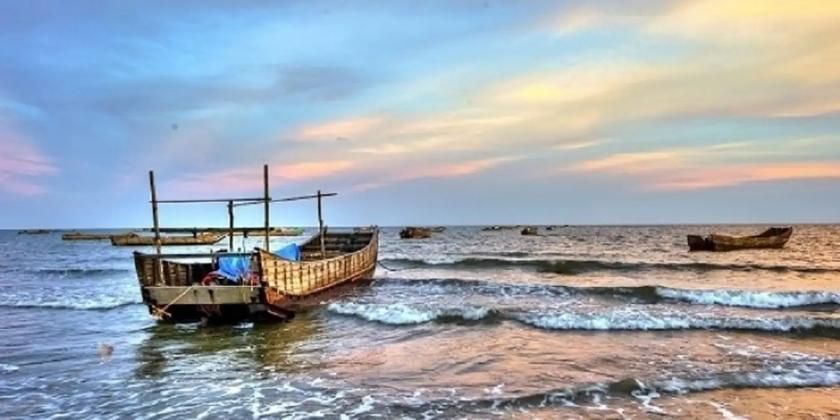
The Tra Co Communal House is dedicated to the six gods who established the village. Built-in 1550, it has two wings, each with seven rooms. Each of these rooms has wooden floors and ceilings. Forty-eight wooden pillars, each over five meters tall, support roof timbers with intricate carvings.
Both wings have carvings of four mythical figures: dragons, unicorns, turtles, and phoenixes. The Linh Khánh Pagoda, also known as the Tra Co or the Nam Tho Pagoda, was erected in 1775 during the reign of King Le Hien Tong (reign: 1740-1786) to worship Goddess Lieu Hanh. This site of 5,000 square meters in a peaceful setting beneath ancient trees has sixty-three statues that include Buddha, Quan Am Thi Kinh (the Goddess of Mercy), and Di Lac (Maitreya Buddha) as well as bronze bells, which were added in 1843.
The Mother Goddess Temple, also known as Tra Co Temple, was built in 1550. The temple is dedicated to a Queen Mother whose statue was washed ashore from the open sea according to local legend. The temple is a sacred site for Vietnamese, who flock there on the twenty-third day of the third lunar month for the annual festival honoring the Mother Goddess. The temple was originally only a small hut in the forest. Today, it stands next to a huge, 700-year-old banyan tree. Tra Co also boasts a shrine dedicated to Nguyen Huu Cau, a leader of an eighteenth-century peasants' insurrection, as well as a Christian church dating from 1880. The church, which was renovated in 1995, features murals and a bell that is over eighty years old.
Tra Co's average annual temperature of 22.7°C, its secluded location away from the bustle of ports, and its unspoiled natural beauty make it a promising site for development. The area is 195 kilometers from Halong Town and 206 kilometers by water from Hai Phong City. From Hanoi, take Highway 18 through Tien Yen to Mong Cai Town and Tra Co Beach.
Ha Long Bay
Seen from above, Ha Bay Long resembles a light blue handkerchief dotted with emeralds. The bay covers only 1,553 kilometers square yet has 1,969 islands. The artistic hand of creation made islands that look like people, animals, and familiar objects. Trống Mái (Cock and Hen) resembles a pair of chickens bobbing in the water; Rùa (Turtle) is a giant tortoise with half-closed eyes; Ông Su (The Monk) looks like an old monk, his face turned out to sea as he clasps his hands in prayer to Buddha, and Dinh Huong (Incense Urn) is like a giant incense-burner atop the altar of the sea.

Ha, Long Bay is deep blue during all seasons. In spring, the islands seem to bob on the water. As summer approaches, they appear to awaken in unison and rise from the blue depths. Fig trees and orchids in cracks along the rocky faces bloom with snowy flowers. Boats take tourists any time of year along meandering channels through the forest of islands. Sometimes, a rock face seems to block the route. However, once the boats come to crack open as if to let boats pass. One scene disappears as yet another panorama opens. The winding route feels endless. nearer, the wall appears Ha Long Bay has a rich collection of grottos and caves concentrated mostly in the UNESCO - protected area. Thien Cung (Heavenly Palace Grotto) feels modern and refined, while Dau Go (Timber-Hiding Cave) is ample and grandiose, and Sung Sot (Amazing Cave) seems deeply secretive. Many sites such as Dong Tien (Fairy Grotto) Lake and the Trinh Nu and Trong (Virgin and Male) Grottoes - are linked to legends and popular tales. Each cave is a grandiose yet refined architectural creation of nature.
At sunset, the mountains' shadows stretch out across the bay, and the water turns gray-blue before suddenly changing to crimson with the sun's last rays. For an instant, the landscape color becomes one and then the sunlight disappears. After the moon climbs into the sky, the sea seems coated with silver, with the lights of Ha Long City reflecting off the water.
Bai Chay Beach
Bai Chay, a large artificial beach close to Halong Bay, is over 500 meters long and 100 meters wide. Hoang Gia Tourism Company's investment has made the site popular. An asphalt road winds between the beach of white sand and casuarina trees. Nearby area restaurants, traditional music theaters, and water-puppet theaters. Hoang Gia Park on Halong Road between Bai Chay Tourist Wharf and Halong Night Market provides water-skiing and jet-skiing. "Bai Chay" (Burning Plain) is associated with many legends. One describes a fleet led by Truong Van Ho with food for the Yuan - Mongol invaders. Vietnamese defenders led by Tran Khanh Du set the entire invading fleet afire. Winds from the northeast carried sparks to the western side of the Cua Luc River Mouth, setting its forests aflame. Hence, the name "Bai Chay" (Burning Plain). Another story says the western side of Cua Luc once had a wharf for seafaring vessels. Local shipyards used casuarina leaves to burn acorn- barnacles off the boats' hulls. People in Hon Gai and other neighboring villages saw these fires and called the area “Bai Chay.”
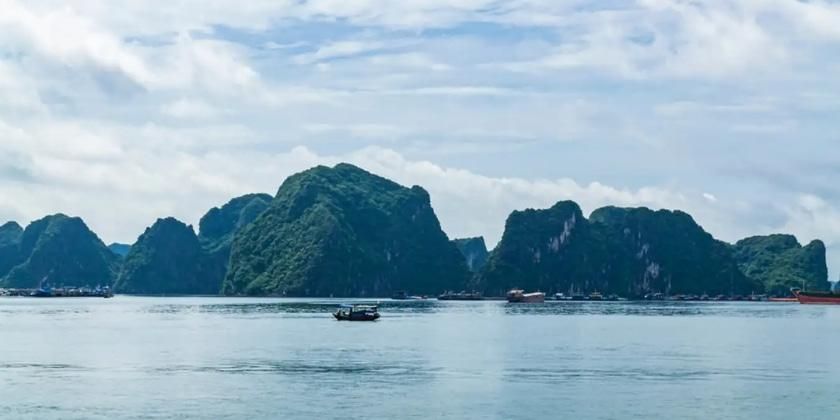
Do Son beach
Do Son Beach, small 22.5, peninsula kilometers in length between the Lach Tray and Van Uc Rivers, is a famous seaside resort twenty kilometers southwest of Hai Phong and a little over a hundred kilometers from Hanoi. Thousands of sandalwood trees shade its beaches, which are surrounded by mountains covered with pines. On summer days, Do Son is alive with tourists from all over the world. Ben Nghieng (Sloping Wharf) at the end of Zone II has high-speed ferries running from Do Son to Halong Bay and to Hon Dau and Cat Ba Islands.
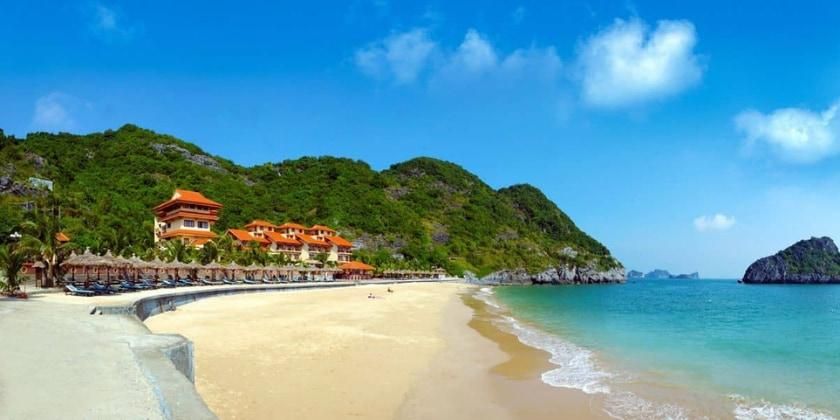
Vietnamese say Do Son is like a dragon’s head facing a precious stone (Hon Dau Island) and that Bach Long Vi Island nearby looks as if it were created by the dragon's whisking tail. Do Son's Tuong Long Tower atop Ngoc Son Mountain dates from the eleventh century. Only the foundation of the ten-story tower remains. However, the inscription on the bricks is clear: “Lý gia đệ tam đế, Long Thụy Thái Bình tứ niên tạo” (The third Ly emperor, the fourth year of Long Thuy Thai Binh [King Ly Thanh Tong]). This would place the date at 1057. Van Ban Pagoda, once the site of the famous Van Ban Bell, is next to the tower. The bronze bell, one of the oldest in Vietnam, was cast during the Tran Dynasty (1225-1400). It is on display now at the History Museum in Hanoi.
The bell fell into the sea during a storm and remained there for hundreds of years. Fishermen retrieved it in 1958 near Zone 1 Beach. Scholars believe the bronze contained a high proportion of gold, which protected the bell during its centuries under seawater. Historical traces also show that the Tran kings used Do Son as a marine base. In 1288, the Vietnamese defeated Yuan-Mongolian invaders, sinking hundreds of their junks during a fierce battle in the mouth of Đại Bàng River near Nhi Son Tower. Tiny Hon Dau Island has a temple to General Nam Hai Than Vuong from the Tran Dynasty (1225-1400), who is a tutelary god protecting fishermen in rough seas. Before fishing trips, sailors stop off at the island to present offerings to secure good luck and increased confidence when facing difficult challenges at sea. Local people honor Nam Hai Than Vuong with an annual festival on the ninth and tenth days of the first lunar month.
In 1741, Nguyen Huu Cau selected Do Son as a navy camp. The current custom of buffalo fighting on the ninth day of the eighth lunar month in conjunction with a festival for the Water God grew from a ceremony Nguyen Huu Cau organized to encourage his soldiers. Soon after the French arrived in Hai Phong in the 1870s, they turned Do Son into a summer resort for themselves and the Vietnamese upper class. Recently, developers have renovated the Van Hoa Hotel, a French colonial resort near the end of Do Son Peninsula, to create a casino with a view of the Hon Dau Island lighthouse four kilometers out to sea.
Attractive Do Son sites include Tuong Long Tower, Pearl Temple, Dragon Stream (with remains from the time of the Ly Dynasty) in Ngoc Hai Ward; Ba De Temple at the foot of Doc Mountain at the end of Xam Wharf in Duyen Hai Ward; a buffalo-fighting festival with the preliminary round during the sixth lunar month and the final matches at the town stadium on the ninth day of the eighth lunar month; the three beaches at Zones I, II, and III; great views from many of the restaurants; "Wharf Without a Number," the starting point of the "Ho Chi Minh Trail on the Sea" for ships traveling from the North to the South during the American War in Vietnam; Do Son Casino, formerly Van Hoa Hotel with its French colonial architecture; the market selling fresh shrimps, tiny shrimps, sá sùng, oysters, dried fish, shrimp paste, sharks' fins, and the swimming bladders of conger pikes.
Of special interest is Bao Dai's Villa on the Vung Hill. In 1999, Do Son Tourist Hotel Company renovated the palace, which is about a thousand square meters. Visitors can see the great lounge where Emperor Bao Dai received visitors. They can also view the bedrooms of Queen Nam Phuong and the princes and princesses. The dining room, living room, reading room, royal private kitchen, and wine cellar have also been restored. Visitors can try on costumes like those worn by the king and have their photographs taken as the queen sits on a throne.
Beaches in Central Vietnam
Canh Duong, which is sixty kilometers from Hue City, is widely regarded as the most beautiful beach in Thua Thien Hue Province. The eight kilometers of beach arc between the Western and Eastern Chan May Mountains. The beach is sheltered, and its sand is white and fine. Canh Duong is popular with tourists and residents alike and is famous for its many sporting activities.
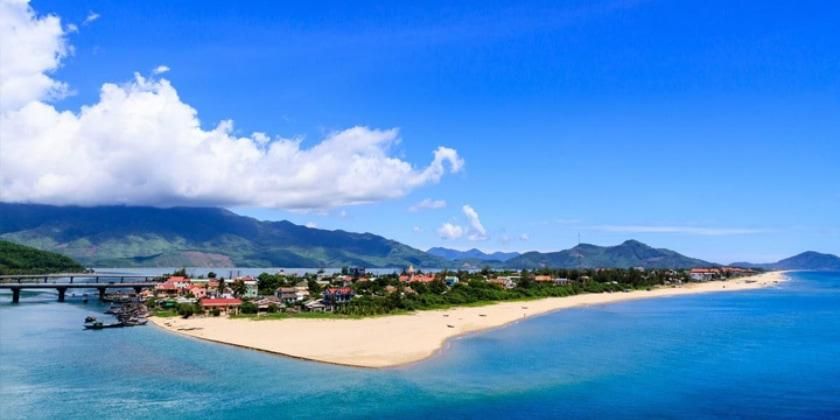
Lang Co Beach, which is ten kilometers long, borders Highway 1A and is near Hai Van Pass. Lang Co once had a fishing village with white storks. When the French occupied the area, they named it "Làng Cò," which means "Stork Village" in Vietnamese. People later mispronounced the tone, saying "Lăng Cô." The sloping beach of white sand has a large area of water that is less than one meter in depth. This and its average temperature of 25°C make Lang Co ideal for family swims.
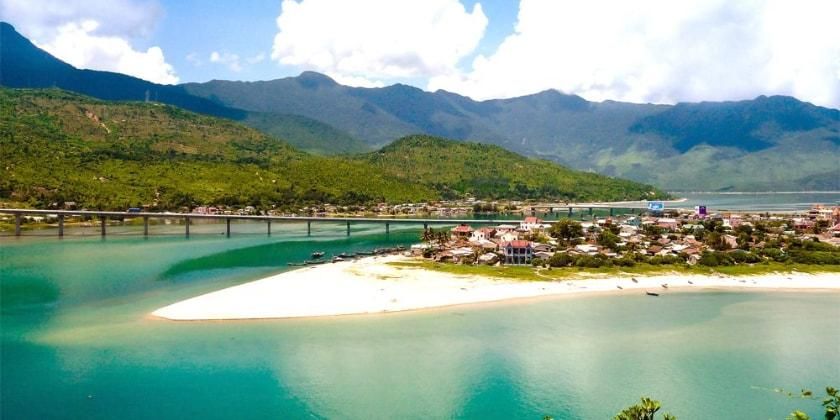
Non-Nuoc Beach runs for five kilometers alongside the Marble Mountains and is bordered by the Dien Ngoc Sea to the south and Da Nang City to the north. The water here is famous for its clarity. Residents cultivate and harvest seaweed for export. Non-Nuoc is popular with domestic and foreign tourists, who can stay in several five-star hotels or less expensive housing.
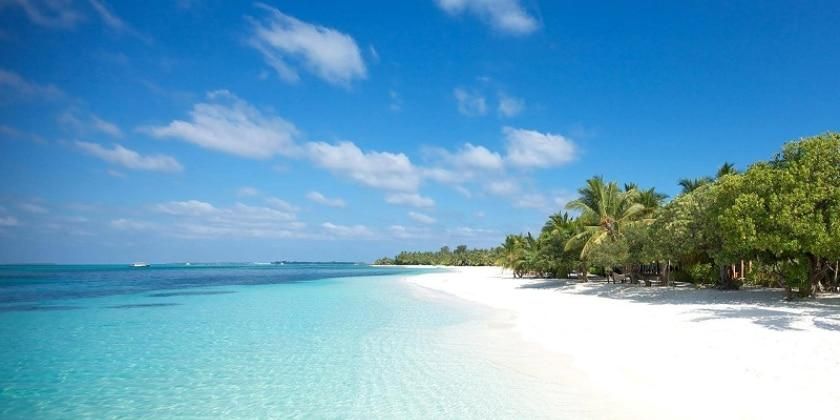
Dai Lanh Beach, which is eighty kilometers north of Nha Trang and closes to Highway 1, has been famous throughout history for its white sands and sea-pine trees. In fact, "Dại Lanh" was carved on one of the Nine Urns in the Mieu Courtyard, which King Minh Menh (rule: 1820-1840) built-in Hue.
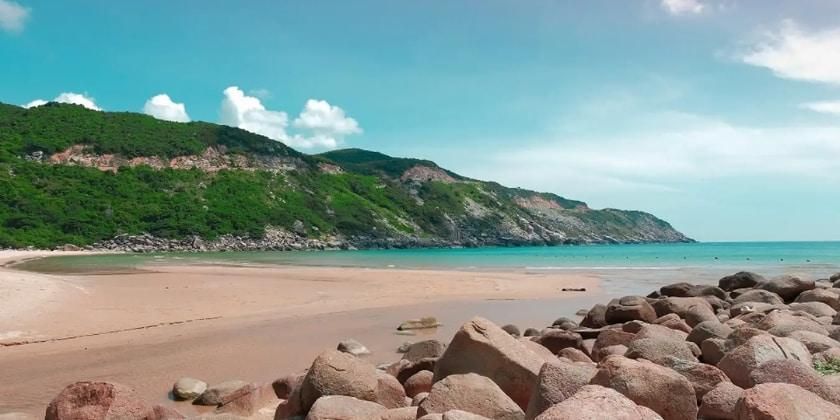
Nha Trang City has a population of 300,000 yet has retained a small-town atmosphere. This city 442 kilometers north of Ho Chi Minh City is well known for its friendly people and its ten kilometers of prime beaches with year-round warm water (average temperature of 26°C) and the lowest humidity in Vietnam. Famous nearby islands are the Truong Sa (Spratleys), Hon Tre, Hon Yen, and Hon Rua.
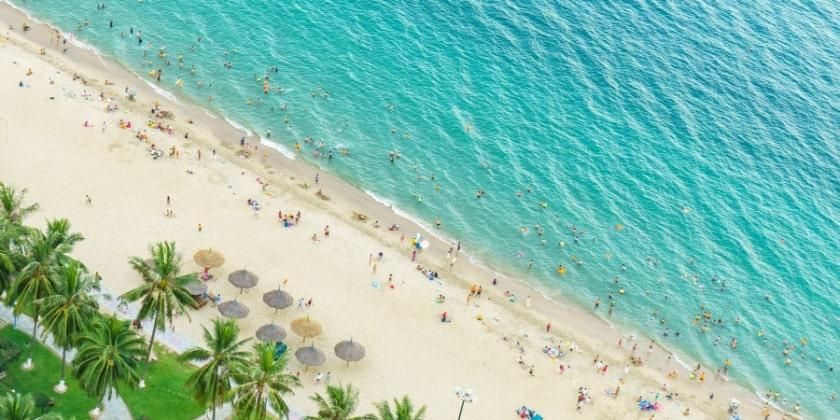
Mui Ne - Hon Rom Beach Area is two hundred kilometers from Ho Chi Minh City and eleven kilometers east of Phan Thiet. Its huge dunes have been the subject of many photographs and video clips. Visitors can follow the Suoi Tien (Fairy Spring), a stream that runs through some of the dunes. The beach, which is internationally known among wind and kite surfers for its prime wind conditions, boasts outstanding facilities for guests.
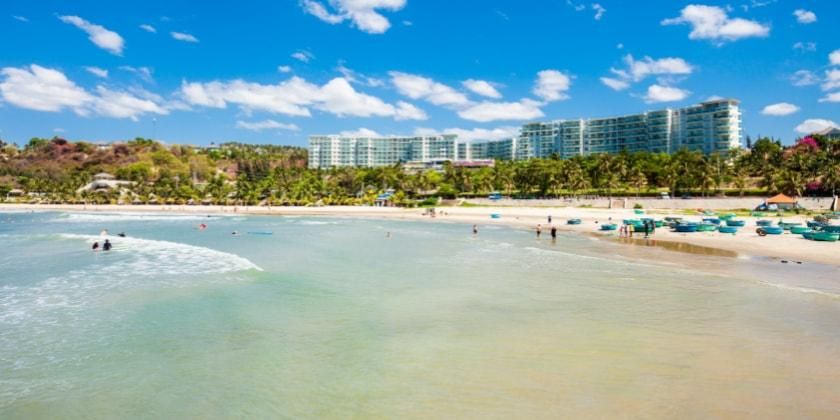
Ba Ria - Vung Tau
Ba Ria Vung Tau Province has a hundred kilometers of shoreline, including seventy-two kilometers of dunes. The topography of the province includes the dunes as well as hills, mountains, and small deltas. Ba Ria - Vung Tau has a monsoon tropical climate. The rainy season with its southwest monsoon runs from May to October; the dry season with winds from the northeast runs from November to April. The annual average temperature is 27°C. Ba Ria - Vung Tau Province is a key gateway for the country's southeast provinces to the Eastern Sea.
Thus, it plays a strategic role as an international seaport, particularly for other Southeast Asian nations. The beautiful beaches near Vung Tau Town have great allure. Local authorities and business leaders wishing to entice tourists to their shores have decided the natural wonders need spicing up with a bit of man-made fun. Jet skiing is a new craze. Nearly a hundred jet ski businesses operate on Vung Tau's beaches; the city's Beach Management Board claims they are both speedy and safe. Visitors have several choices. A three-seater has a top speed of between 110 and 150 kilometers per hour, whereas a two-seater travels at a more sedate rate of between fifty-five and seventy-five kilometers per hour. Drivers start at a low speed and play relaxing music as their guests settle in but will turn up the throttle for those wanting a rush. The more adventurous will soon be holding their breath and trying to quell the adrenaline as their racing craft tackles the huge waves. Don't worry: The drivers' skills are up to the task of keeping visitors safe until the ride is over.

Others might prefer a trip to the scenic mountain peaks of Nui Lon (Big Mountain) or Nui Nho (Small Mountain). Nearby are the legendary White House (once a famed fortress) and a seven-story statue of Jesus Christ that blends Vietnamese and French influences.
The forest's seductive perfume of cajeput and red jasmine lingers in the memory long after a walk in the mountains, reminding visitors of the unforgettable beauty of the land and the charm of its people.
Many tourists visit Ba Ria - Vung Tau without making the trip out to the Con Dao Archipelago even though the site is only a short plane trip or an inexpensive boat ride away.
Seven island cruises can help visitors appreciate the splendor of the Con Dao Archipelago, including the tropical forests of Bai Ong Dung, the reddish gold or snow-white sands of Bai Dam Trau, and the coral reefs and multi-colored fish around Hon Tre Lon and Hon Tre Nho.
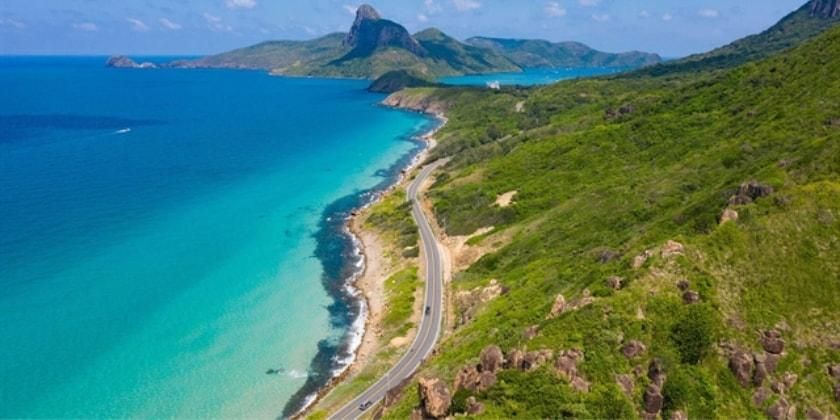
Visitors can stop over at Ben Dam to watch the bustling fishing boat traffic in the harbor. From Ben Dam, they can go on to observe the antics of the red-faced monkeys on Hon Tai and marvel at the immense forests of coconut trees on Hon Cau. They can travel to Hon Bay Canh to watch sea turtles coming ashore to lay their eggs.
Ba Ria - Vung Tau Province’s Tourist Service is planning to develop yet more entertainment and sightseeing choices to make a trip to the region even more satisfying. Nevertheless, current services are sufficient to ensure that visitors can relax, enjoy themselves, and appreciate the natural environment.




